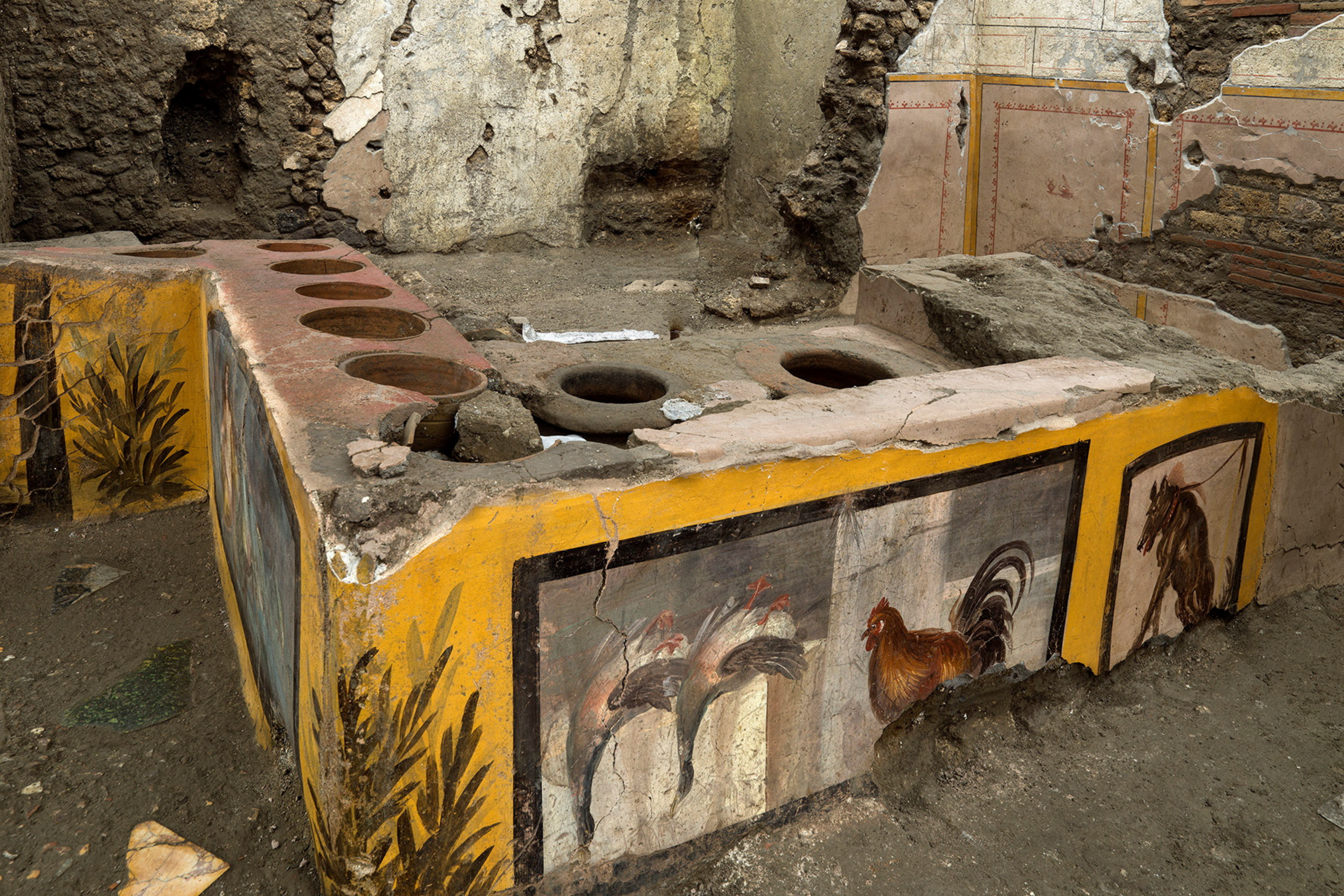
The ancient city of Pompeii was once a popular travel destination, ruined by the volcanic eruption of Mount Vesuvius in 79 A.D. Kept safe beneath a layer of ash for almost 1,600 years, it wasn’t until the mid-1700s that a group of explorers came across the city frozen in time. Three hundred years later, archaeologists have made another incredible find, uncovering a hot food and drinks shop that provided street food for Roman tourists. The discovery, which included small amounts of food left in the shop’s jars, shows the strength of the ancient, once-busy city against time.
What Happened to Pompeii?
Several thousand years ago, the ancient Roman city of Pompeii was a booming city, home to between 10,000 and 20,000 people. Located 14 miles southeast of present-day Naples, the Italian town was a travel destination for some of Rome’s wealthiest vacationers. Fancy homes and grand villas lined the paved streets, while impressive public buildings ruled over the landscape. Tourists and locals walked between open-air town squares, cafes, and bathhouses.
Volcanic activity was not uncommon or rare for the townspeople. The city of Pompeii is located about 10 miles from Mount Vesuvius, an active volcano that has erupted for thousands of years. Just 16 years before the famous eruption, a large earthquake shook the area, warning of what was to come. In August of 79 A.D., the volcano finally erupted, tossing lava, rocks, and hot ash 21 miles into the air for all the townspeople to see. The ash flew so high that writer Pliny the Younger could watch the eruption from across the bay. He later wrote a letter saying, “Darkness fell, not the dark of a moonless or cloudy night, but as if the lamp had been put out in a dark room.” Pliny the Younger described a darkness that reminded him of a room without any candle light.
As the hot lava cooled in the air, it fell back to Earth as small bits of rock and ash. While most of the villagers had plenty of time to pack their things, some Pompeiians did not leave the town. As more ash fell, the air became harder to breathe in, and people and buildings collapsed. By the second day of volcanic activity, the lava and falling bits of rock had killed 2,000 people. The eruption ruined the entire city, leaving it and some of its citizens buried in ash.
Ancient City, New Discoveries
Pompeii remained protected under a thick layer of ash for over 1,600 years, kept safe against harsh weather and anyone who might harm the city. It wasn’t until 1748 that a group of explorers began digging, surprised to find a village frozen in time. Since its discovery, archaeologists have excavated or dug up hundreds of buildings, from colorful shops and houses to an outdoor theater. Archaeologists look at old things and figure out how people used to live. Everyday objects, household goods, and even skeletons have been found, stuck in the same position as they were almost 2,000 years ago. In addition, some archaeologists have been lucky enough to come across jars of preserved fruit and bread left in villagers’ ovens.
In December of 2020, archaeologists discovered a termopolium, which is Latin for a hot food and drink counter. Today, we might think of the store as a street food truck or fast food chain like McDonalds or Taco Bell. In the shop, archaeologists found jars with what remained of different animals like fish, snails, and beef. From the discovery, archaeologists could tell that the street merchant used and sold many of those foods to prepare meals for Roman tourists. They also found cooking tools and a drinking bowl. In addition, the front counter was covered in brightly colored frescoes, which are paintings done in watercolor on walls. The frescoes showed the many types of food sold there, from chicken to duck. “This is an extraordinary find. It’s the first time we are excavating an entire termopolium,” Massimo Osssana, director of the Pompeii archaeological park, said. The discovery of a termopolium is important because archaeologists have not found a shop as protected against forces like weather, which can break down buildings over time.
The find is an exciting addition to archaeologists’ 300-year-long dig. Although archaeologists have found two-thirds of the town as of 2020, they remain just as interested as they were in 1754. Moreover, Pompeii continues to be one of Italy’s largest tourist attractions, wowing all those who visit its impressive and timeless streets. It is perhaps no mystery why Pompeii is a UNESCO world heritage site, respected for its lively culture and history.
0 of 4 Questions completed
Questions:
You have already completed the quiz before. Hence you can not start it again.
Quiz is loading…
You must sign in or sign up to start the quiz.
You must first complete the following:
0 of 4 Questions answered correctly
Your time:
Time has elapsed
You have reached 0 of 0 point(s), (0)
Earned Point(s): 0 of 0, (0)
0 Essay(s) Pending (Possible Point(s): 0)
Select the sentence that BEST summarizes the article.
CCSS.ELA-Literacy.CCRA.R.2
According to the article, WHY were archaeologists able to uncover so many objects from the ancient city?
CCSS.ELA-Literacy.CCRA.R.1
According to the article, which of the following is NOT an effect the Mount Vesuvius eruption had on Pompeiians?
CCSS.ELA-Literacy.CCRA.R.3
Read the following sentence from “Ancient City, New Discoveries“:
“Since its discovery, archaeologists have excavated or dug up hundreds of buildings, from colorful shops and houses to an outdoor theater.”
Which word or words could replace “excavated” without changing the meaning of the sentence?
CCSS.ELA-Literacy.CCRA.R.4
0 of 1 Questions completed
Questions:
You have already completed the quiz before. Hence you can not start it again.
Quiz is loading…
You must sign in or sign up to start the quiz.
You must first complete the following:
0 of 1 Questions answered correctly
Your time:
Time has elapsed
You have reached 0 of 0 point(s), (0)
Earned Point(s): 0 of 0, (0)
0 Essay(s) Pending (Possible Point(s): 0)
Choose an event from the text. Write a short narrative to describe the event using details.
This response will be reviewed and graded after submission.

Copyright 2021 – NexGen News. All Rights Reserved.